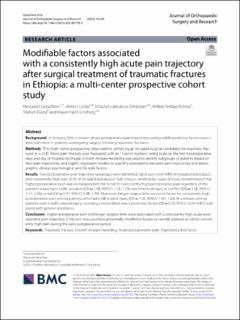| dc.contributor.author | Enbakom, Mestawet Getachew | |
| dc.contributor.author | Lerdal, Anners | |
| dc.contributor.author | Småstuen, Milada Cvancarova | |
| dc.contributor.author | Eshete, Million Tesfaye | |
| dc.contributor.author | Desta, Tilahun | |
| dc.contributor.author | Lindberg, Maren Falch | |
| dc.date.accessioned | 2023-04-24T08:56:15Z | |
| dc.date.available | 2023-04-24T08:56:15Z | |
| dc.date.created | 2023-04-23T12:42:43Z | |
| dc.date.issued | 2023 | |
| dc.identifier.citation | Journal of Orthopaedic Surgery and Research. 2023, 18 (288), . | en_US |
| dc.identifier.issn | 1749-799X | |
| dc.identifier.uri | https://hdl.handle.net/11250/3064426 | |
| dc.description.abstract | Background
In Ethiopia, little is known about postoperative pain trajectories and possible predictive factors associated with them in patients undergoing surgery following traumatic fractures.
Methods
This multi-center prospective observational cohort study included surgical candidates for traumatic fractures (n = 218). Worst pain intensity was measured with an 11-point numeric rating scale on the first 4 postoperative days and day of hospital discharge. Growth mixture modeling was used to identify subgroups of patients based on their pain trajectories, and logistic regression models to quantify associations between pain trajectories and demographic, clinical, psychological, and life style factors.
Results
Two postoperative pain trajectory subgroups were identified: rapid pain relief (48% of included individuals) and consistently high pain (52% of included individuals). Sub-analysis stratified by cause of injury demonstrated that higher preoperative pain was an independent risk factor for consistently high postoperative pain regardless of the patient’s injury type: traffic accident (OR = 1.48, 95% CI 1.23–1.79), machine/tool injury or conflict (OR = 1.58, 95% CI 1.11–2.26), or fall (OR = 1.47, 95% CI 1.08–1.99). Moreover, longer surgical time was a risk factor for consistently high postoperative pain among patients who had a fall-related injury (OR = 1.02, 95% CI 1.00–1.03). In contrast, among patients with a traffic-related injury, receiving a nerve block was a protective factor (OR = 0.19, 95% CI 0.04–0.87) compared with general anesthesia.
Conclusion
Higher preoperative pain and longer surgical time were associated with a consistently high acute postoperative pain trajectory. Clinicians may use these potentially modifiable factors to identify patients at risk for consistently high pain during the early postoperative period. | en_US |
| dc.language.iso | eng | en_US |
| dc.rights | Navngivelse 4.0 Internasjonal | * |
| dc.rights.uri | http://creativecommons.org/licenses/by/4.0/deed.no | * |
| dc.title | Modifiable factors associated with a consistently high acute pain trajectory after surgical treatment of traumatic fractures in Ethiopia: a multi‑center prospective cohort study | en_US |
| dc.title.alternative | Modifiable factors associated with a consistently high acute pain trajectory after surgical treatment of traumatic fractures in Ethiopia: a multi‑center prospective cohort study | en_US |
| dc.type | Peer reviewed | en_US |
| dc.type | Journal article | en_US |
| dc.description.version | publishedVersion | en_US |
| cristin.ispublished | true | |
| cristin.fulltext | original | |
| cristin.qualitycode | 1 | |
| dc.identifier.doi | 10.1186/s13018-023-03770-0 | |
| dc.identifier.cristin | 2142662 | |
| dc.source.journal | Journal of Orthopaedic Surgery and Research | en_US |
| dc.source.volume | 18 | en_US |
| dc.source.issue | 288 | en_US |
| dc.source.pagenumber | 10 | en_US |
| dc.relation.project | NORAD, direktoratet for utviklingssamarbeid: ETH-13/0024 | en_US |
| dc.relation.project | Norges forskningsråd: 287816 | en_US |
| dc.relation.project | Helse Sør-Øst RHF: 2022007 | en_US |

